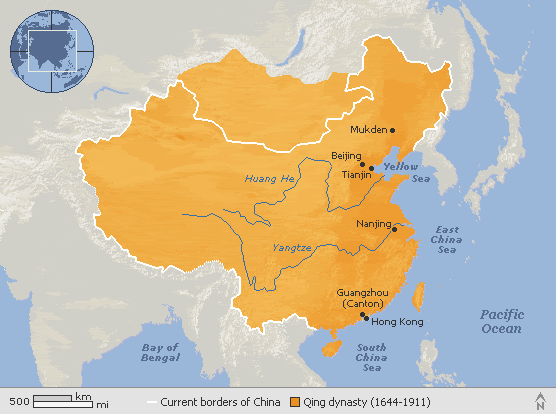China’s Settlement of Land Border Disputes
In the backdrop of China’s ongoing disputes with its neighbours over islands in the East China and South China seas, some in the Western, Japanese and Southeast Asian press have been hammering China over its supposed ‘bullying’ and ‘trampling’ non-sovereign territory. A previous post traced the Diaoyu Islands dispute to the First Sino-Japanese War and outright annexation of the islands by Japan. This post seeks to dispel the notion that present disputes taint China as an expansionist power.
During the more than 60-year reign of Emperor Qianlong (1735-1799), the Qing Empire reached the pinnacle of territorial expansion, encompassing Manchuria, Mongolia, Xinjiang, Tibet, and Taiwan. The Qing Empire was much larger than the Han and Tang dynasties and arguably even bigger than the mighty Yuan Dynasty under Kublai Khan. Territorial expansion largely occurred under the rule of non-indigenous rulers such as the Mongols and Manchus. The borders of present day People’s Republic largely follow that of the Qing, less Mongolia.
Due to “unequal treaties”, the weak late Qing emperors lost much territory to the Russian Tsar, ceding what is now the Russian far east and parts of Xinjiang in the far west. When the Communists took power in 1949, it inherited a total of 23 territorial disputes, mostly with states along its contiguous land borders including most importantly the Soviet Union and India.
In 1962, a one-month border war was fought between China and India resulting in the latter’s utter defeat that still resonates loudly in the Indian national psyche. In 1969, border clashes broke out between the Chinese and the Soviets over Zhenbao (Damanskii) Island on the Ussuri River that defined part of the northeast border, a dispute that was later resolved with Russia in the 1990s and 2000s. In 1979, China launched an equally brief attack across the northern borders of Vietnam as reprisal against Vietnam’s invasion of Kampuchea (Cambodia). Vietnam was seen by the Chinese as a surrogate for the Soviet Union in expanding throughout Indochina.
Soon after the implosion of the Soviet Union, China commenced negotiations with several Central Asian Republics – Tajikistan, Kazakhstan, and Kyrgystan – and Russia; continued marathon deliberations with the Indians; and moved to repair relations with Vietnam. By the late 2000s, China had settled all land border disputes save those with India and tiny Bhutan. In 17 disputes, points out M Taylor Fravel, a security expert at MIT, China offered significant concessions to accept “less than half of the territory being disputed”.
Srikanth Kondapalli, a China scholar at New Delhi’s Jawaharlal Nehru University, grudgingly agrees: “Whether China actually gave up territory or made a substantial concession is a debatable question (but China overall) has been liberal in border dispute resolution”. (Both scholars were cited in January 2011 Asia Times article “China Plays Long Game on Border Disputes” by Bangalore based journalist Sudha Ramachandran.)
China’s border negotiations with India have been the most vexing. A 1959 diplomatic note sent by Chinese Premier Zhou Enlai recognized a Line of Actual Control (LAC) that includes a section of the McMahon Line. A year later, he offered a swap to the Indian government: recognition of India’s sovereignty over territory south of McMahon Line in the eastern sector in exchange for recognition of China’s sovereignty over Aksai Chin in the western sector. But, this olive branch was summarily rejected. In 1981, paramount leader Deng Xiaoping offered a similar “package settlement” but eight rounds of talks proved futile.
On a state visit to China in 1988, Indian Prime Minister Rajiv Gandhi agreed to a joint working group on boundary issues but that too made little progress. Neither did a 1993 agreement to define the LAC. Three years later, both sides agreed to set up “confidence-building measures” to avoid border clashes. Although sporadic incidents have occurred along the McMahon Line to the present day, disagreements have been confined to within a kilometer of the LAC.
As for the settlement of the remaining six territorial disputes both on land (with India) and at sea (with Japan, Vietnam, Philippines, Malaysia, and Brunei), journalist Ramachandran suggests that China is now less likely to extend concessions to settle them but the possibility for the use of force is low. However, the role of the US in backing the Japanese on the Diaoyus and a closer military relationship between the US and India could become destabilizing factors.


0 Comments
Trackbacks/Pingbacks